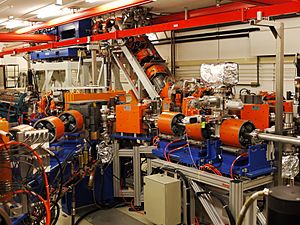Free-electron laser facts for kids
A free-electron laser, or FEL, is a laser that produces a very bright beam of light. It is basically a super flashlight. It shares the same optical properties as conventional lasers such as emitting a beam consisting of coherent electromagnetic radiation which can reach high power. The FEL used operating principles to form the beam that are very different operating principles of a conventional laser. Unlike gas, liquid, or solid-state lasers such as diode lasers, in which electrons are excited while bound to atoms, FELs use a relativistic electron beam as the lasing medium which moves freely through a magnetic structure, hence the term free electron. The free-electron laser has the widest frequency range of any laser type, and can be widely tunable, currently ranging in wavelength from microwaves, through terahertz radiation and infrared, to the visible spectrum, to ultraviolet, to X-rays.
Free—electron lasers were invented by John Madey in 1976 at Stanford University. The work builds on research done by Hans Motz and his coworkers who made the first undulator at Stanford in 1953 using the wiggler magnetic configuration which is at the heart of a free-electron laser. Madey used a 24 MeV electron beam and 5 m long wiggler to amplify a signal. Soon afterward, other laboratories with accelerators started developing such lasers.
Free-electron lasers use a lot of electricity when they operate. To reduce the energy needed to keep them operating, scientist use an energy recovery linear accelerator to recycle the high-energy electron beam that activates the laser.
- Madey, John, "Stimulated emission of bremsstrahlung in a periodic magnetic field". J. Appl. Phys. 42, 1906 (1971)
- Madey, John, Stimulated emission of radiation in periodically deflected electron beam, US Patent 38 22 410,1974
- Boscolo, et al., "Free-Electron Lasers and Masers on Curved Paths". Appl. Phys., (Germany), vol. 19, No. 1, pp. 46–51, May 1979.
- Deacon et al., "First Operation of a Free-Electron Laser". Phys. Rev. Lett., vol. 38, No. 16, Apr. 1977, pp. 892–894.
- Elias, et al., "Observation of Stimulated Emission of Radiation by Relativistic Electrons in a Spatially Periodic Transverse Magnetic Field", Phys. Rev. Lett., 36 (13), 1976, p. 717.
- Gover, "Operation Regimes of Cerenkov-Smith-Purcell Free Electron Lasers and T. W. Amplifiers". Optics Communications, vol. 26, No. 3, Sep. 1978, pp. 375–379.
- Gover, "Collective and Single Electron Interactions of Electron Beams with Electromagnetic Waves and Free Electrons Lasers". App. Phys. 16 (1978), p. 121.
- "The FEL Program at Jefferson Lab" [1]
Images for kids
-
Schematic representation of an undulator, at the core of a free-electron laser.
See also
 In Spanish: Láser de electrones libres para niños
In Spanish: Láser de electrones libres para niños



